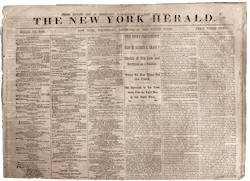February 12, 1861; The New York Herald
The President elect left Springfield, Illinois, yesterday morning, en route for the White House at Washington, via Buffalo, Albany and New York. He will reach this city, according to the published programme… on Tuesday, the 19th instant. His journey is divided into easy stages, and all the arrangements thereof have been adapted to the contingencies of a triumphal march. Holding over several days in this metropolis, and a day or two, perhaps, at Philadelphia and Baltimore, Mr. Lincoln may not reach Washington till the end of the month. It is understood, however, that he desires to be there in season to appropriate several days and evenings to consultations with the republican members of Congress upon the important subject of his Cabinet, which does not as yet appear to be half made up.
But, dismissing all these incidentals, the question still recurs, what will be the line of policy marked out in Mr. Lincoln’s inaugural touching the revolutionary troubles and sectional difficulties which his election has precipitated upon the country? For many weeks past his reputed home organ at Springfield, and our special correspondent there, and the Hon. Massa Greeley, and everybody else supposed to speak by authority, have had only one report to make–to wit: that the President elect stands firm upon the Chicago platform, that he has no compromise to make with rebels and traitors, but that his fixed and unalterable purpose is enforcement of the laws.
We are at length, however possessed of information from which we feel authorized to declare that the President elect, in his inaugural address, will submit a proposition of pacification to the country, in the form of a National Convention for the reconstruction of the Union. Mr. Seward, in his first speech in the Senate after his appointment as Mr. Lincoln’s Premier, pretty broadly suggested that he would be ready to go for something of that sort: ‘after these eccentric secession and disunion movements shall have subsided, and when calmness shall have resumed its wonted sway over the public mind.’ In this suggestion, we now perceive, our cautious Senator foreshadowed the intended peace offering from the incoming administration–a National Convention for the revision of the federal constitution, whereby the States contemplating secession and the seceded States may be restored to the Union.
A National Convention–a good thing; but how is it to be reached? The fifth article of our federal constitution decrees that Congress, whenever two thirds of both houses shall deem it necessary, shall propose amendments to the constitution, or, on the application of the Legislatures of two thirds of the several States, shall call a convention (a national Convention) for proposing amendments, which, in either case, shall be valid to all intents and purposes, as part of the constitution when ratified by the Legislatures of three fourths of the several States, or by conventions in three fourths thereof, as the one or the other mode of ratification may be proposed by congress.
